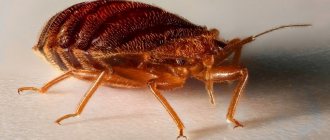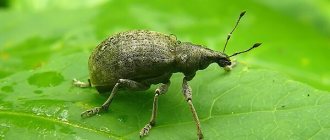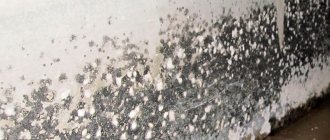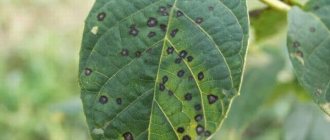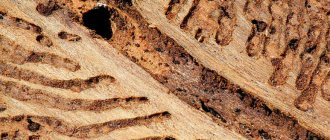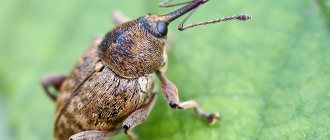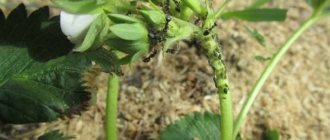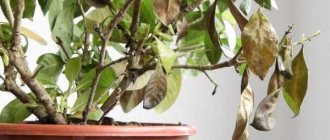What is this
Fungus and mold that “attack” the walls of a building are colonies of simple microorganisms that become visible due to their obvious abundance. They are characterized by high vitality, the ability to reproduce due to moisture in the atmosphere, and no need for sunlight. Thanks to these properties, microorganisms grow very rapidly, and the inhabitants of the house are faced with the question: “How to remove fungus from the walls in the apartment?”
Fungus and mold
Types of mold
Mold fungi can live and develop on various surfaces: concrete, wood, fabrics, stone, varnish and paint. Under favorable conditions, several types of harmful microorganisms can attack one apartment at once. The most famous are:
- White house mushroom. A dangerous enemy of wooden buildings, capable of destroying the structure as quickly as possible with rapid development. Very difficult to destroy;
- Black mold. Appears in the form of dark blots of various colors. It grows rapidly, filling the space with a mass of spores. It is considered the most dangerous mushroom for human health;
- Blue fungus. Gives walls a grayish-blue tint. Capable of deforming the paintwork, drawing moisture from the inside;
- White mold. Capable of forming on various materials and damaging them as quickly as possible;
- Actinomycetes. They soften and gradually destroy the wood;
Rotting fungi. Characteristic only for wood materials. There are dry and wet rot. The first type of damage manifests itself in a brown tint, compression and splitting of the wood. Damage to wet rot is indicated by dark bands and subsequent cracks.
Fungus on the walls
We use borax to eliminate
- fast and safe;
- no final cleaning of the wall is required.
What do we have to do
- dissolve 100 grams of borax in 1 liter of water;
- soak a brush in the solution and clean the wall;
- Dry the entire surface thoroughly.
If your knowledge of chemistry is limited to a school course and this was not true a long time ago, then here is some brief background information: borax is the sodium salt of boric acid; it is part of many detergents. It is also found on sale in the form of small crystals, which seems very convenient for use.
Causes of mold
In order to understand how to remove fungus from the walls of an apartment, it is worth deciding on the reasons for its formation. The appearance of microorganisms can be caused by several factors:
- Room humidity is above 60%;
- Lack or insufficient heating in the house;
- Small thickness of the walls, unable to protect them from freezing in frosty weather;
- Improper laying of bricks or joining of reinforced concrete slabs;
- Uninsulated window slopes;
- Poor quality installation of plastic windows;
- Little or no air circulation;
- Poor quality waterproofing of foundations in private buildings.
Negative effects of mold on humans
Treating walls against mold is required not only to protect the room. The fungus poses a considerable danger to the human body. It constantly releases microscopic spores, which, spreading throughout the house, land on the skin and fly into the lungs.
The spores contain toxic substances, contact with which can cause serious problems for people. The list of ailments caused by mold is quite extensive: runny nose, headache, allergies, asthma, persistent cough, nausea. Contact of moldy fungus with the elderly, children and those with a weak immune system is particularly dangerous.
There's one mushroom here
What causes fungus to appear on the walls in an apartment?
Residents of communal houses often observe peeling plaster, peeling wallpaper, or simply an unpleasant odor in the room. It's all due to high humidity. The increased water content in the air allows microorganisms to develop more actively, hence the whole problem.
Most people's bathrooms and living rooms are equipped with a weak ventilation system that simply cannot remove all the moisture.
IMPORTANT: The fungus actively reproduces at temperatures of 15-20 degrees, with air humidity over 70%.
Prevention
Mold forms in damp places. It can be found especially often in the bathroom, in the joints between the tiles.
A good preventive measure against mold and mildew on walls is to ensure an optimal microclimate. If natural ventilation is not enough, it is recommended to install special equipment in the ventilation duct.
You should not “throw” wet things around the apartment. They need to be dried unfolded on a special stand or on a stretched rope.
Cold bridges can trigger the formation of mold. External insulation will help prevent their occurrence. The discovery of fungus on the balcony usually indicates defects in the installation of the drain and poor-quality waterproofing.
If you find places where the paint has begun to peel off and swell, it is necessary to clean them from the paint coating, treat them with an antiseptic composition and apply a new coat of paint.
Fungus caused by leaks
Armed with a bite
- copes well with almost all microorganisms;
- suitable for cleaning ordinary tableware, in 9% concentration;
- no need to dilute in water.
What do we have to do
- just soak a rag or sponge in vinegar and apply it to the wall;
- leave for an hour and then rinse with plain water;
- Be sure to dry the wall.
As you can see, everything is very simple and, as experience shows, quite effective.
Features of work on various surfaces
Treating apartment walls against fungus and mold has its own nuances depending on the type of surface.
Painted canvases must be removed from cracked and swollen paint. If this is not done, then the spores hidden under the coating will sooner or later appear on the surface again.
Things are a little more complicated with suspended ceilings and drywall. The porous surface allows the fungus to penetrate deeply. In particularly difficult situations, the affected surface must be completely replaced.
If the wallpaper is covered with mold, it is also necessary to remove it and then treat the wall with an antiseptic.
Fungus and mold
Sequence of repair activities
Before you start planning and thinking about how to remove fungus from the walls, it is recommended to carry out a number of preparatory activities. Porous surfaces require special attention.
- Work begins with removing old wallpaper;
- Then you need to thoroughly clean the “sick” area with an iron spatula or brush, completely removing the loose plaster;
- Treat the canvas with a cleaning composition to open the cement pores;
- Apply the anti-mold and mildew agent on the walls until the surface is well saturated;
- Prime the canvas with a deep absorption antiseptic;
- After waiting for the solution to harden, repeat the priming procedure;
- Plaster, prime and putty the walls;
- Perform final wall cladding.
Removal of moldy fungus in the cellar is accompanied by drying and waterproofing of the room.
Trying hydrogen peroxide
- a common means of desperately fighting fungus;
- produces a slightly whitening effect.
What should be done
- moisten the sponge in 3% peroxide;
- clean the wall surface.
Women often use this solution to dye their hair blonde. However, it can be safely used for a better cause. However, be careful: this product may leave unsightly marks on the wall of your apartment.
How to treat walls (Folk methods)
You can try to remove local damage to walls using relatively harmless and affordable folk remedies. Even ordinary peroxide and furatsilin can become worthy helpers.
All work on cleaning walls containing fungal mold must be carried out strictly using rubber gloves and a protective gown.
Recipes
- 0.5 cups white vinegar, 4 tbsp. l. borax and 4 tbsp. Stir warm water until smooth. Spray the resulting remedy for fungus on the walls onto the affected surface, let it sit for a while (5-10 minutes), wipe dry and repeat the procedure.
- Treat the affected canvas several times with vinegar at intervals of 1 hour.
- Mix 100 grams of bleach and a liter of water. Apply the resulting solution to smooth, mold-affected surfaces. Wait a little, rinse and repeat the procedure a couple more times.
- A decent remedy against fungus on walls is 3% hydrogen peroxide. It is necessary to take into account the fact that the liquid has bleaching properties.
Folk remedies do not provide a 100% guarantee of fungal removal, but are quite effective at the initial stage of the infection.
Preparations of chemical origin
Today, many chemicals are produced, so the question is: “How to treat walls against mold?” Shouldn't cause any big problems. The choice of a suitable composition should be accompanied by a study of the instructions, since the chosen product for removing fungus and mold on the walls may be suitable only for a certain type of microorganisms.
Chemical compounds with antifungal and antimicrobial characteristics are considered the most effective. You can purchase both ready-made preparations and mixtures that require preliminary preparation. You can dilute the antiseptic against mold and mildew on the walls with turpentine, clean water or white alcohol. Oil-based formulations (for example, creosote) are quite popular.
Top most effective antiseptics for mold
- Stop mold (Olympus) is an aggressive composition recommended mainly for cellars, bathrooms and other overly damp rooms. Colorless, safe for pets and people, does not contain toxic or chlorine compounds. Suitable for almost any surface.
- Abedis 06 is a fairly toxic drug that can kill any type of fungus. Does not change the quality of facing materials. Apply to the affected area for a day and wash off with water.
- Fongifluid Alpa is an active fungicidal agent against fungus on the walls in the apartment. Sold in ready-made liquid form. Made with anti-mold and antifungal ingredients.
- The biocide is an effective drug that gets rid of primary and secondary fungal colonies. It is used based on the following ratios: 70-100 ml/m2. In addition to the main components, it contains pleasant flavors.
- Xiolate is the drug with the best results. It acts on the basis of penetrating isotopes, destroying the structure of mold in the very depths of building materials.
- Teflex is a powerful drug that is safe for humans and pets.
If the area affected by fungus and mold is too extensive, then complete disinfection of the room is required using the cold or hot fog method. The substance contains a generated active form of a disinfectant that can destroy microorganisms anywhere in the building.
Types of mold in your home and how it is dangerous for your health
If you think that there is no mold in your house or apartment, then you are very mistaken. There is a lot of mold in absolutely every house or apartment. The only difference is that in one home there are no conditions for its growth, and in the other there is simply a resort for mold and it grows and rejoices, then you clearly see it.
What is mold? Let's start with what mold is. Mold is nothing more than a fungus. And as we all know, any fungus is spore-bearing. This means that from just one very tiny spore, which we simply cannot see without a microscope, a giant colony can develop, which is already visible even from afar.
What kind of mold is there? There are several types of mold. The most common mold is black mold, but you can also encounter pink, white and blue mold. Now we will look at each type of mold separately and find out why each type is harmful individually.
Black mold
Black mold is the most common; this fungus often appears on the walls of houses and apartments. Her appearance simply horrifies homeowners. Very often we may not see mold for a long time if it, for example, has formed behind a closet or under the carpet, but you will certainly smell it. When mold is already raging in your house and you smell dampness, at this moment you need to sound the alarm and immediately look for the source of the smell and the source of mold.
Black mold is called so because of its color; it has a black color, which is simply impossible not to see. This fungus has many strains and each strain is dangerous to our health in its own way. Each strain prefers certain surfaces for its growth. We will look at each one separately.
Black mold with white mycelium - it can appear on absolutely any surface. It has a white base and the ends of the fungi are black. This is a very dangerous mold for health. It causes the disease aspergillus, this disease affects not only people, but also domestic animals.
Phoma mold – has the fourth degree of pathogenicity. This mold, on the contrary, has a black mycelium covered with white spores. It is dangerous because it affects the respiratory tract.
Common black mold is the most common strain and the mold is completely black. It is this mold that is most often found in our homes. It appears at high humidity and dampness. Very often it is found in old non-residential buildings or in cold, damp apartments. She is very harmful to your health; if you have such a neighbor, you risk your health. Near such a neighborhood, intestinal disorders and respiratory tract diseases can begin. If you do not get rid of it, serious diseases of the digestive tract and respiratory tract can develop.
The second strain of common black mold does not differ in appearance from the previous strain. What makes it different is that it grows incredibly quickly. From a small point it can simply turn into a giant colony. When you see the speed of growth, you will be simply shocked. By postponing the fight against it for a couple of days, you can see how a spot of a couple of centimeters will turn into a huge spot of more than a meter. This is an almost harmless mold to health, but a huge pest for surfaces.
One of the strains of black mold is initially light in color and only as it grows it darkens and turns black. However, don’t worry, it won’t cause harm to your health and it won’t come into your home either. But the garages are her favorite “resort” with an all-inclusive function. This mold feeds on kerosene, diesel fuel and similar materials. The fungus is very tenacious and it is difficult to get rid of it, but you don’t have to sound the alarm if it lives in your garage, it does not cause any harm to your health.
Black mold is found on all food products. You can easily find it on vegetables or fruits in your refrigerator. The only way it will harm you is by ruining your products. If you find the slightest sign, immediately throw away the spoiled product, because it will spread quickly.
Medical black mold - this strain became the first antibiotic; it was invented from black mold.
Green mold
This mold is often confused with moss; it is very similar in appearance. The mold has a rich green color and the surface is not smooth. Its main habitat is organic matter (soil, manure, vegetables and fruits, clay wall surfaces).
It is dangerous because it very often affects your food products. It’s not uncommon for people to make a big mistake: when they see a small green spot on a fruit, vegetable or other product, they cut off the mold and think that the product can be consumed because the mold has been removed. This is strictly prohibited; even a small pocket of green mold instantly affects the entire product and penetrates through its pores into all tissues. By eating such a product, you risk getting quite severe food poisoning.
Pink mold
You won't find this type of mold on your walls or ceilings, or even under your bathtub. However, you can see it on foods that are rotting, such as vegetables and fruits. It can also affect cereals and various grain crops that are improperly stored.
This mold does not harm your health, but you should still not eat affected foods.
White mold
White mold Mukor as it is also called , does not form on walls and other surfaces in your home. It grows on trees and on the soil surface. You can find this mold in flower pots in your home. This usually happens when the soil does not have time to dry out.
This mold rarely causes harm to health, but in rare cases it can affect the internal organs of both people and animals. Infection occurs by entering the circulatory system. It can enter the circulatory system through damaged skin; this can happen if you touch the mold while having a cut or deep scratch. The consequences of infection are quite severe. Therefore, do not touch it if you have any skin lesions.
Blue mold
This type of mold has a blue or bluish color, which is why it got its name. You won't find one like this in your home. It grows exclusively on trees. It is this mold that is specially contaminated in cheeses for the production of very expensive varieties of blue cheese. This mold is completely harmless to your health.
Gray mold
Gray mold has the same gray color; it is a frequent guest in houses and apartments. This mold grows well on absolutely any surface and feels wonderful. It can be on walls, furniture and even food. Such mold settles very tightly in the home and it is very difficult to remove this mold.
Gray mold is quite harmful to your health; it affects the respiratory tract.
